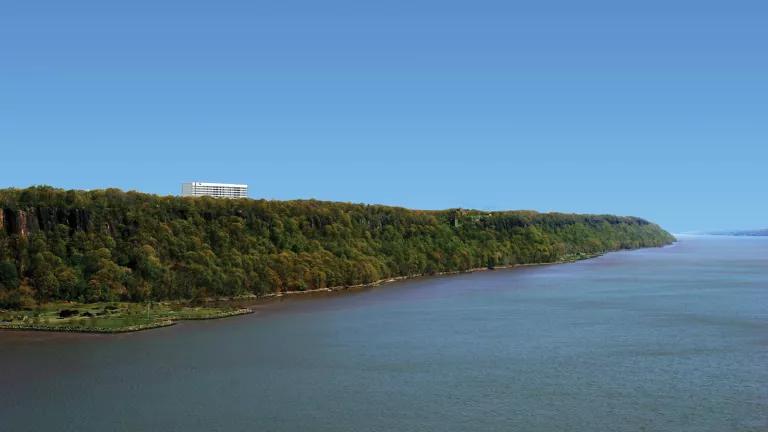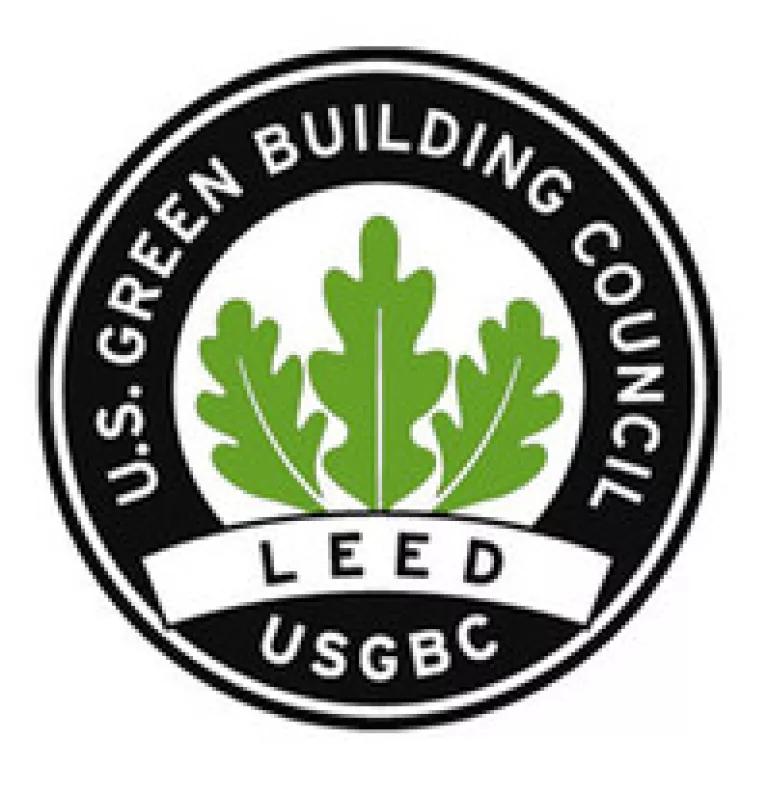
Criticism continues to mount against LG Electronics’ plan to build a 143-foot headquarters on top of the Hudson River Palisades in Englewood Cliffs, New Jersey – spoiling one of the few remaining stretches of natural beauty in the nation’s densest metropolitan region.
A simulation of LG Electronics' planned 143-foot headquarters as it would be seen from the middle of the Geoerge Washington Bridge. Technical rendering via Saratoga Associates.
The latest stakeholder to raise strong concerns is the U.S. Green Building Council (USGBC), which created and administers the highly coveted LEED green building certification program.
In a Huffington Post piece published last week, Rick Fedrizzi, President and CEO of the U.S. Green Building Council, wrote that LG’s efforts to advance a building that would “break the tree line of this magnificent vista” was a “bad decision” and that the company should “reconsider” its design.
USGBC joins a long list of prominent voices that are calling on LG to redesign its headquarters.
This list includes: four former New Jersey governors (two Republicans and two Democrats); six New Jersey mayors from neighboring towns; leading New Jersey state senators; and New York’s Governor Andrew Cuomo, U.S. Senators Chuck Schumer and Kirsten Gillibrand, Attorney General Eric Schneiderman, and several other top elected officials in New York City and State.
Add this opposition to that of the editorial boards of New Jersey’s two leading newspapers – the Bergen Record and the Newark Star-Ledger – as well the New York Daily News and The New York Times.
Also calling for a lower building design are leading New Jersey civic and planning groups, as well as 32 investment firms, mutual funds and foundations with more than $294 billion in assets under management, which cautioned LG about “permanent reputational risks” if its current plans were pursued.
And on the environmental side, the U.S. Environmental Protection Agency, the National Park Service, 11 of the country’s top environmental groups, and many of the region’s leading environmental organizations including Scenic Hudson and the New Jersey Conservation Foundation are also opposed to LG’s current plan.
Despite this unprecedented backlash, LG somehow still continues to tout its new
headquarters as “green” because they aspire to obtain LEED certification for the final building.

LEED, or Leadership in Energy and Environmental Design, is a 14-year-old green building certification program that recognizes environmentally sound building strategies and practices around the country. Buildings can receive different levels of LEED certification based upon a menu of credits they accrue in five green design categories: sustainable sites, water efficiency, energy and atmosphere, materials and resources and indoor environmental quality.
LEED is a prized and highly respected designation, only bestowed once a building its completed and certified as actually meeting USGBC’s stringent standards. There is no pre-certification of LEED status before the construction is completed.
It shouldn’t come as a surprise that LG has widely publicized its intention to seek LEED certification for its new headquarters. But it is surprising that, with no other source of environmental support for its building, LG is using the future hope of LEED status to justify its park-destroying design.
Indeed, LG repeatedly talks about LEED in the press in an effort to deflect wide-scale environmental criticism over the building plan, which was designed by the architechtural firm HOK.
And John Taylor, LG’s VP of Public Affairs, recently was quoted as claiming that the building design was “critical” to obtaining LEED status.
The U.S. Green Building Council disagrees.
In his blog post Fedrizzi writes, “while LEED is the de facto standard for defining green building, it is not, and was never intended to be, a proxy for defining a good corporate neighbor.” He adds: “To suggest that somehow LEED is forcing them to make this bad decision is ludicrous.”
Rob Watson, who is often identified as the founder of LEED (and who is a former NRDC Senior Scientist) also takes strong exception to LG’s use of possible LEED certification support its tall building plan.
In court papers filed in the ongoing litigation over the planned LG building, Watson states, “a building exceeding 60 feet—above which it breaks the tree line—does NOT add materially, if at all, to the project’s ability to achieve LEED Gold or Platinum status.” He continues: “It is also my opinion that there are no site constraints or LEED certification constraints that would prevent a low-rise building from being successfully built on this site and achieving LEED Gold or Platinum status.”
So, the bottom line is this: LG continues to mislead the public with its claims that it needs to build tall to obtain LEED status – an assertion that the head of the U.S. Green Building Council flatly rejects.
But the good news is that there continues to be a win-win solution: LG can build a new lower-rise headquarters that could be celebrated as a green building.
As Fedrizzi writes, “Good project teams can always find creative ways to meet a LEED credit's intent and honor the place the building will stand.”

